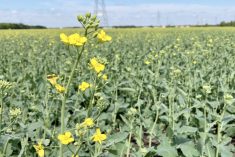Winnipeg | Reuters –– Soybeans, once a novelty in western Canadian fields, are poised to reach record-large acreage again this year, and some of the world’s biggest seed companies are betting they have further room to grow in a region known for wheat and canola.
Farmers on the eastern side of the Prairies are turning to soybeans for high returns and as shorter-season varieties make them viable in Western Canada and across northern U.S. states.
Monsanto expects Canadian farmers to sow 5.8 million acres this year, up from 5.6 million in 2014, with Ontario the biggest grower, said Cornie Thiessen, who leads the agricultural products company’s Canadian trait and licensing business.
Read Also

Senft to step down as CEO of Seeds Canada
Barry Senft, the founding CEO of the five-year-old Seeds Canada organization is stepping down as of January 2026.
Growth lies in Western Canada, and Monsanto expects farmers there to nearly double acreage to three million within five years.
“We actually expect that (expansion) to continue for quite a few years,” Thiessen said.
U.S. farmers are also expected to expand 2015 soybean plantings.
Canada’s soybean output is only 1/18th the size of U.S. production, limiting its effect on global trade. Canada exported 2.4 million tonnes of soybeans in 2013-14, about 44 per cent of that year’s crop. China, the biggest importer, bought 895,000 tonnes.
Monsanto boosted its Canadian soybean seed investment in the past two years, pushing it to a similar level as canola. Its Roundup Ready soybeans are the dominant brand in Canada, competing with DuPont Pioneer and Syngenta.
The companies mainly invest in shorter-season varieties and adapt them for specific regions.
Syngenta, for one, announced Tuesday it had picked up registration for the first triple zero (000) soybean variety in its product pipeline. The variety, S0009-M2, reaches full maturity in 107 days on average, the company said.
The company said its breeding program is now focused on developing a “full line” of varieties for the Prairie soybean market.
“We still have a lot of room to grow,” said Steve Schnebly, senior research manager at DuPont, which is increasing investment in Canadian soybeans and corn.
Dwayne Couldwell, senior merchandiser of oilseeds for grain handler Paterson Grain, said soybeans offered farmers bigger gross returns than canola and cost less to plant.
They often mix into rotations with canola and wheat, which remain popular.
To be sure, acres of other crops like lentils and corn have also expanded on the Prairies, making for a crowded field of choices.
Limits on soybeans’ growth include a lack of significant Prairie processing capacity and the grain’s lower protein content there than in the U.S. China buys Canadian soybeans at a discount to blend with higher-protein supplies, Couldwell said.
— Rod Nickel is a Reuters correspondent covering the agriculture and mining sectors from Winnipeg. Includes files from AGCanada.com Network staff.




















